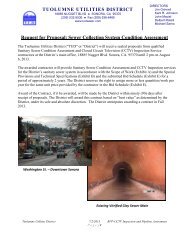Historic Resource Evaluation Project - Tuolumne Utilities District
Historic Resource Evaluation Project - Tuolumne Utilities District
Historic Resource Evaluation Project - Tuolumne Utilities District
You also want an ePaper? Increase the reach of your titles
YUMPU automatically turns print PDFs into web optimized ePapers that Google loves.
Water conveyance features are ubiquitous in the California gold country, but perhaps<br />
none are more intact than those constructed for mining purposes in <strong>Tuolumne</strong> and<br />
adjacent Calaveras County. These features of earth-bermed ditches, take outs, flumes,<br />
drainage crossovers, spill gates, cross gates, sandtraps, reservoirs, holding ponds and<br />
more are remarkable dendritic remnants of the early development of these foothill<br />
counties. In engineering terms, canals were the primary conduits of water, carrying water<br />
to laterals and ditches, but in some instances laterals would carry water to ditches and in<br />
other instances canals carried water directly to ditches. <strong>Historic</strong>ally, however, this is a<br />
definition of canals, laterals, and ditches that would be difficult to determine from the<br />
names of water conduits in <strong>Tuolumne</strong> County. Therefore, the historic names of the<br />
systems have been utilized in this report.<br />
Since the initial study for <strong>Tuolumne</strong> County (Peak & Associates 1987), intensive studies<br />
conducted for the Caltrans East Sonora Bypass <strong>Project</strong>, private and public development<br />
projects, and this study have uncovered additional information, requiring that the names<br />
and histories of the ditches and their components be revised. Also, the ditches had<br />
different names at different periods in time, or for different uses or destinations, further<br />
confusing the issue. A Ditch Optimization Study was conducted in 2002 over a period of<br />
a few weeks. This survey was wide-ranging, covering a corridor varying in width along<br />
each ditch (Davis-King 2003). (There is no documentation for the Section 4 or Phoenix<br />
ditches from this work, and some segments of a few others were not surveyed.)<br />
<strong>Evaluation</strong>s of the TUD System and Its Elements<br />
When a water conveyance system is evaluated as an eligible district or as<br />
an individually eligible property with multiple components, contributing<br />
and noncontributing elements must be identified. Contributing structures,<br />
buildings, objects, and sites are those elements associated with the<br />
property’s period and area of significance which also possess an adequate<br />
level of integrity. Noncontributing elements were either not present<br />
during the historic period, or they were not part of the property’s<br />
documented significance, or they have lost integrity and no longer reflect<br />
historic character. When considered as a historic district, a water<br />
conveyance system must contain a high proportion of contributors to<br />
noncontributors (JRP and Caltrans 2000:96).<br />
As stated by noted Swiss architect Jacques Herzog (2011):<br />
There is no particular point in history. History is a process. We believe<br />
every time and every contribution has its importance, versus something<br />
that freezes one moment in time.<br />
Therefore, the following descriptions, histories, and evaluations have been compiled from<br />
the available archival resources and surveys of thirteen individual ditches. The systems<br />
and their features are described and evaluated for the National Register of <strong>Historic</strong> Places<br />
(NRHP) below.<br />
Foothill <strong>Resource</strong>s, Ltd. 4.3 TUD Ditch Sustainability <strong>Project</strong><br />
Francis Heritage, LLC<br />
<strong>Historic</strong> <strong>Resource</strong> <strong>Evaluation</strong> Report




